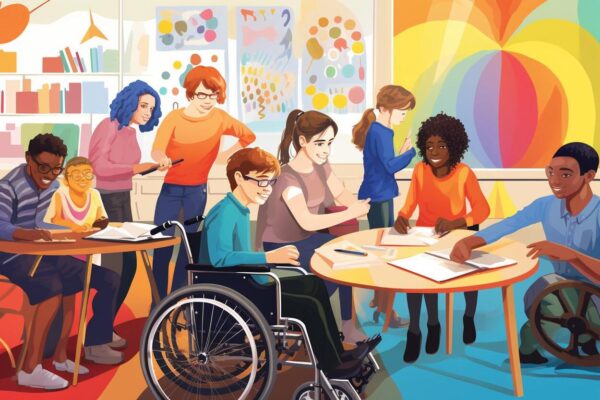Special needs education aims to provide inclusive and equitable learning opportunities for students with diverse abilities and challenges. With an emphasis on personalized approaches, collaboration, and access to resources, inclusive education fosters a supportive environment where all students can thrive. By implementing effective strategies, educators can bridge gaps, celebrate diversity, and empower every learner to reach their full potential. This guide explores key strategies for inclusive teaching, highlighting how they contribute to equitable education for students with special needs.
Understanding Special Needs Education

Special needs education encompasses a wide range of learning, emotional, behavioral, and physical disabilities, including:
- Learning Disabilities: Dyslexia, dyscalculia, and auditory processing disorders.
- Developmental Disabilities: Autism spectrum disorder (ASD), attention-deficit/hyperactivity disorder (ADHD), and intellectual disabilities.
- Physical Disabilities: Mobility impairments, visual impairments, and chronic health conditions.
- Emotional and Behavioral Challenges: Anxiety, depression, and conduct disorders.
Inclusive education recognizes that every student has unique needs and strives to create environments where all learners can succeed together.
The Principles of Inclusive Education
Inclusive education is guided by core principles that ensure equitable access and participation for all students:
- Equity: Providing the necessary support to meet individual needs and bridge learning gaps.
- Accessibility: Ensuring physical, technological, and curricular access for all students.
- Collaboration: Involving educators, families, and specialists in developing and implementing individualized plans.
- Flexibility: Adapting teaching methods, materials, and assessments to accommodate diverse learning styles.
- Empowerment: Encouraging students to advocate for themselves and build confidence in their abilities.
Key Strategies for Inclusive and Equitable Teaching
- Individualized Education Plans (IEPs):
- Collaborate with special education professionals and families to develop IEPs tailored to each student’s needs.
- Set measurable goals, track progress, and adjust strategies as necessary.
- Differentiated Instruction:
- Modify lessons to accommodate diverse learning styles and abilities.
- Use a variety of teaching methods, such as visual aids, hands-on activities, and technology-based tools.
- Universal Design for Learning (UDL):
- Apply UDL principles to create a flexible curriculum that benefits all learners.
- Provide multiple means of engagement, representation, and expression to meet varied needs.
- Assistive Technology:
- Incorporate tools like screen readers, speech-to-text software, and adaptive keyboards to support students with disabilities.
- Use educational apps and platforms designed for students with specific challenges, such as dyslexia or autism.
- Classroom Accommodations:
- Adjust the environment to minimize distractions and enhance focus (e.g., seating arrangements, noise-canceling headphones).
- Provide extra time for assignments and assessments, and break tasks into manageable steps.
- Foster Social Inclusion:
- Encourage peer interactions and cooperative learning to build social skills and relationships.
- Implement buddy systems or peer mentoring programs to support students with special needs.
- Positive Behavior Support (PBS):
- Use proactive strategies to reinforce desired behaviors and address challenges constructively.
- Provide clear expectations, consistent routines, and rewards for positive behaviors.
- Ongoing Professional Development:
- Train educators in inclusive teaching practices, classroom management, and understanding specific disabilities.
- Encourage participation in workshops, seminars, and online courses on special education topics.
The Role of Collaboration in Special Needs Education
Effective collaboration is crucial for creating inclusive classrooms:
- Educators and Specialists:
- Teachers, special education professionals, speech therapists, and occupational therapists work together to address students’ needs.
- Families:
- Involving parents and guardians in the educational process fosters trust and provides valuable insights into students’ strengths and challenges.
- Peers:
- Encouraging classmates to support and include students with special needs promotes empathy and acceptance.
Challenges in Special Needs Education
Despite progress, inclusive education faces challenges that require ongoing attention:
- Resource Gaps:
- Limited funding and access to trained professionals can hinder effective implementation of special education programs.
- Teacher Workload:
- Managing a diverse classroom can be demanding without adequate support or training.
- Stigma and Bias:
- Societal attitudes toward disabilities may lead to marginalization or misunderstanding.
- Technological Barriers:
- Lack of access to assistive technology can impede learning opportunities for some students.
Success Stories: The Impact of Inclusive Education
Inclusive education has a transformative impact on students, teachers, and communities:
- Enhanced Learning Outcomes:
- Research shows that inclusive classrooms benefit all students, improving academic achievement and social-emotional skills.
- Increased Confidence:
- Students with special needs gain self-esteem and independence when supported in inclusive environments.
- Stronger Communities:
- Inclusive education fosters understanding, acceptance, and collaboration, creating more empathetic and equitable communities.
The Future of Special Needs Education
As education evolves, special needs education continues to embrace innovation and inclusivity:
- Technology Integration:
- Emerging technologies like AI-driven learning tools and virtual reality offer new possibilities for personalized education.
- Policy Advancements:
- Policies like the Individuals with Disabilities Education Act (IDEA) in the U.S. and similar frameworks worldwide ensure legal protections and resources for students with special needs.
- Global Collaboration:
- International organizations and advocacy groups are working to share best practices and promote inclusive education worldwide.
Conclusion: Building a More Inclusive Future
Special needs education is a cornerstone of equitable and compassionate learning. By adopting inclusive strategies, fostering collaboration, and addressing challenges, educators can create environments where every student feels valued and empowered. As we continue to innovate and advocate, special needs education will play a vital role in building a more inclusive, understanding, and equitable world for all learners.